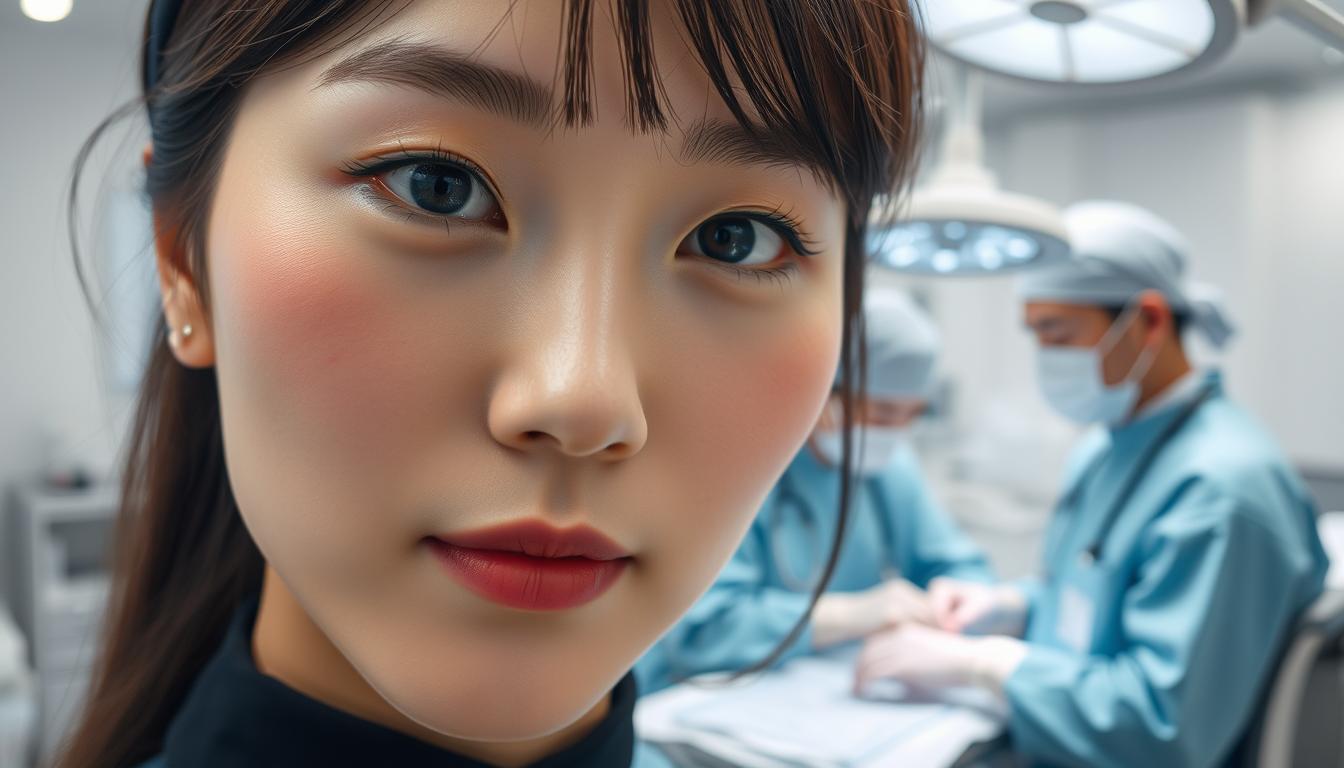South Korea has established itself as a global leader in plastic surgery, with the highest number of procedures per capita worldwide. According to ISAPS data as of 2021, one in five Korean women have undergone cosmetic surgery, compared to one in twenty in the United States.
The country’s prominence in the industry can be attributed to a combination of cultural, historical, and economic factors. In 2018, a total of 464,452 patients visited South Korea for cosmetic surgery, a 16.7 percent increase from 2017.
This comprehensive guide will explore the most popular procedures, costs, and what international patients can expect when seeking surgery in Korea.
Key Takeaways
- South Korea has the highest number of plastic surgery cases per capita globally.
- Cultural and historical factors contribute to Korea’s dominance in the cosmetic surgery industry.
- Popular procedures and costs will be examined in this comprehensive guide.
- International patients can expect high-quality care and facilities in Korea.
- The number of international patients seeking surgery in Korea has seen significant growth.
The Rise of South Korea as the Plastic Surgery Capital
Korea’s transformation into the plastic surgery capital of the world is a phenomenon driven by various cultural and societal factors. Over the past few decades, plastic surgery has become increasingly accepted in Korean society.
Historical Development of Cosmetic Surgery in Korea
The history of cosmetic surgery in Korea dates back several decades, but it wasn’t until the 1990s that the industry began to gain significant traction. The economic growth and increased exposure to Western media during this period contributed to a shift in beauty standards, paving the way for the normalization of plastic surgery. By 2015, 66% of respondents believed that a woman could undergo plastic surgery for marriage, a significant increase from 38% in 1994.
The prevalence of plastic surgery among women also saw a substantial rise, from 5% in 1994 to 31% in 2015. According to a Statista survey in 2020, nearly 25% of women aged 19-29 had undergone plastic surgery, compared to only 2% of men in the same age group.
Cultural Factors Driving the Popularity
Several cultural factors have contributed to the popularity of plastic surgery in Korea. The intense competition in education and employment has created a culture where appearance is considered a valuable asset. The influence of K-pop and K-drama has also played a significant role in shaping beauty standards and normalizing cosmetic enhancements.
The emphasis on conformity and collective identity in Korean culture has further contributed to the widespread adoption of certain beauty ideals. As a result, plastic surgery has become a common consideration for many, particularly young women.
| Year | Percentage of Women Supporting Plastic Surgery for Marriage | Percentage of Women Who Have Undergone Plastic Surgery |
|---|---|---|
| 1994 | 38% | 5% |
| 2015 | 66% | 31% |
The data indicates a significant shift in societal attitudes towards plastic surgery over the past few decades. As the industry continues to evolve, it is likely that plastic surgery will remain a prominent aspect of Korean culture.
Korea and Plastic Surgery: Market Overview
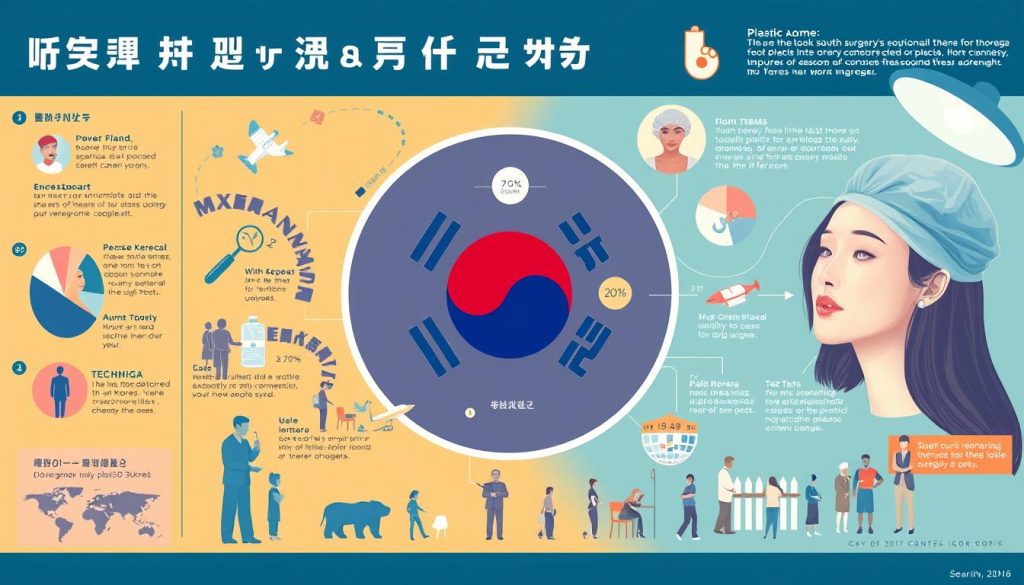
South Korea’s plastic surgery industry has witnessed significant growth, establishing the country as a global hub for cosmetic procedures. The industry’s expansion is driven by factors such as advanced surgical techniques, highly specialized surgeons, and competitive pricing, making it an attractive destination for both domestic and international patients.
Current Market Size and Growth
The plastic surgery market in South Korea has experienced remarkable growth over the years. In 2019, a total of 211,218 tourists visited South Korea for plastic surgery, contributing to the industry’s substantial revenue. The country’s reputation for delivering high-quality cosmetic procedures at competitive prices has been a significant factor in this growth.
The number of foreign patients visiting plastic surgery clinics in South Korea has been steadily increasing, with 190,000 patients over four years. Thailand and China account for the largest number of international patients, drawn by the country’s advanced techniques and specialized care.
Korea’s Position in the Global Cosmetic Surgery Industry
South Korea has firmly established itself as the global capital of plastic surgery, boasting the highest per capita rate of cosmetic procedures worldwide. The country’s emphasis on innovation and quality has positioned it at the forefront of the global cosmetic surgery industry.
The Korean government’s active support for medical tourism has played a crucial role in the industry’s growth. By implementing policies to facilitate international patient care, the government has recognized the economic value of medical tourism and contributed to the country’s standing as a leading destination for plastic surgery.
Most Popular Plastic Surgery Procedures in Korea
Korea’s plastic surgery scene is characterized by a variety of procedures, some of which are particularly favored by locals and international patients alike. The country’s clinics offer a range of surgeries that cater to different aesthetic goals, from facial enhancements to body contouring.
Double Eyelid Surgery (Blepharoplasty)
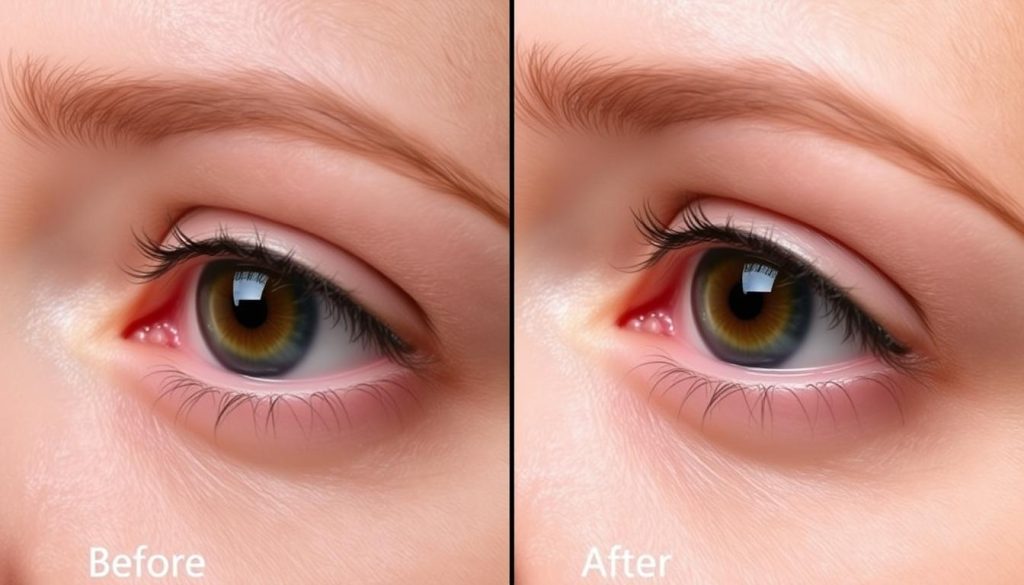
Double eyelid surgery, or blepharoplasty, is one of the most common procedures in Korea. It involves creating a crease in the upper eyelid to give the appearance of larger, more rounded eyes. This surgery is particularly popular among East Asians, as it enhances the natural features without drastically altering them.
Rhinoplasty
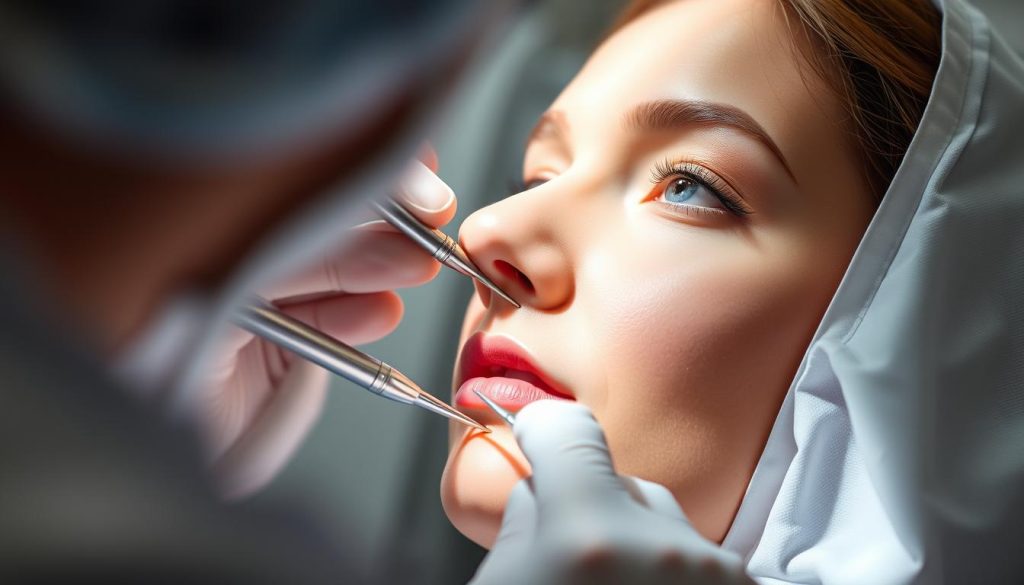
Rhinoplasty, or nose reshaping surgery, is another popular procedure in Korea. It involves modifying the shape and size of the nose to achieve a more balanced facial profile. Korean clinics are known for their advanced techniques in rhinoplasty, offering both functional and aesthetic improvements.
V-Line Surgery and Facial Contouring

V-line surgery and facial contouring are highly sought after in Korea, where a slim, V-shaped face is considered a beauty ideal. These procedures involve reshaping the jaw and facial bones to achieve a more defined, slender facial contour. The result is a more aesthetically pleasing face that aligns with current beauty standards.
Body Contouring and Other Common Procedures
Body contouring procedures are also very popular, focusing on creating slim, proportionate figures. Techniques such as liposuction with fat grafting are used to achieve ideal body proportions, often transferring fat to the breasts or face. Breast augmentation in Korea typically favors smaller, more natural-looking implants, differing from Western preferences for larger enhancements.
The popularity of these procedures is not limited to women; male plastic surgery has grown significantly, now representing approximately 30% of all cosmetic procedures in Korea. Recovery times vary depending on the procedure, with most patients requiring 1-3 weeks before returning to normal activities.
The Korean Approach to Plastic Surgery
The Korean approach to plastic surgery is distinct in its focus on subtle, natural enhancements. This approach is driven by a combination of cultural preferences, advanced techniques, and a highly competitive market.
Emphasis on Natural-Looking Results
Korean plastic surgeons are known for their emphasis on achieving natural-looking results. This is particularly evident in procedures such as double eyelid surgery, where the goal is to create a crease that looks natural and complements the patient’s facial features. The use of advanced techniques and a deep understanding of facial anatomy enable surgeons to deliver results that are both aesthetically pleasing and subtle.
Dr. Lee and his team at VIP have performed over 20,000 successful surgical procedures, demonstrating their expertise in achieving natural-looking results. Their experience with pioneering procedures such as autologous rib cartilage rhinoplasty and extended deep plane facelifts has set new standards in the industry.
Advanced Techniques and Technologies
The Korean plastic surgery industry is at the forefront of adopting advanced techniques and technologies. The use of 3D imaging and computer simulation technologies allows patients to visualize potential results before undergoing surgery, enhancing the decision-making process. Minimally invasive procedures are also increasingly popular, offering the benefits of reduced recovery times and less noticeable scarring.
Korean surgeons often specialize in specific procedures, performing them with high frequency and developing refined techniques through extensive experience. This specialization, combined with the competitive nature of the market, drives continuous innovation and the adoption of cutting-edge technologies.
The outcome of these advancements is that patients can expect high-quality care and exceptional results from their surgical procedures. With a focus on natural-looking results and the use of advanced techniques, Korean plastic surgery continues to set a high standard in the industry.
Korean Plastic Surgery Costs and Value
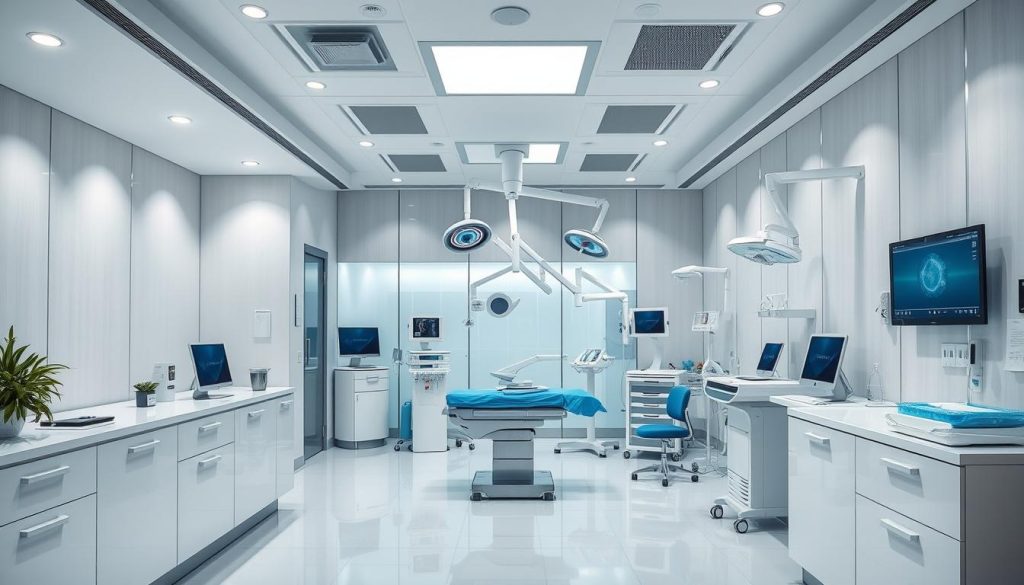
Understanding the costs associated with plastic surgery in Korea is crucial for making informed decisions. The cost of surgery can vary significantly based on several factors, including the type of procedure, the surgeon’s experience, and the clinic’s facilities.
Price Comparison with the United States
When considering surgery in Korea, one of the primary factors is the cost comparison with other countries, particularly the United States. Generally, plastic surgery clinic prices in Korea are competitive, often lower than those in the U.S., without compromising on quality.
The average cost of certain procedures in Korea can be significantly less than in the U.S., making it an attractive option for medical tourists. For instance, double eyelid surgery, a popular procedure, is often priced lower in Korea.
What Influences the Cost of Procedures
Several factors influence the cost of surgery in Korea. These include:
- The surgeon’s reputation and experience significantly impact pricing, with renowned specialists commanding premium rates.
- Clinic location affects costs, with facilities in prestigious areas like Gangnam typically charging more than those in other districts.
- The complexity and combination of procedures influence pricing, with customized treatment plans often offering better value than individual procedures.
- Facility standards and technology used during surgery contribute to cost variations between clinics.
- Aftercare services are often included in Korean plastic surgery packages, providing better overall value compared to the itemized billing common in Western countries.
Patients can expect to spend several days in Korea for their surgery and recovery, with some clinics offering packages that include accommodation and post-operative care for a seamless experience.
In cases where multiple procedures are undertaken together, the overall cost can be more manageable, as clinics often offer discounts for combined treatments.
Medical Tourism for Plastic Surgery in Korea
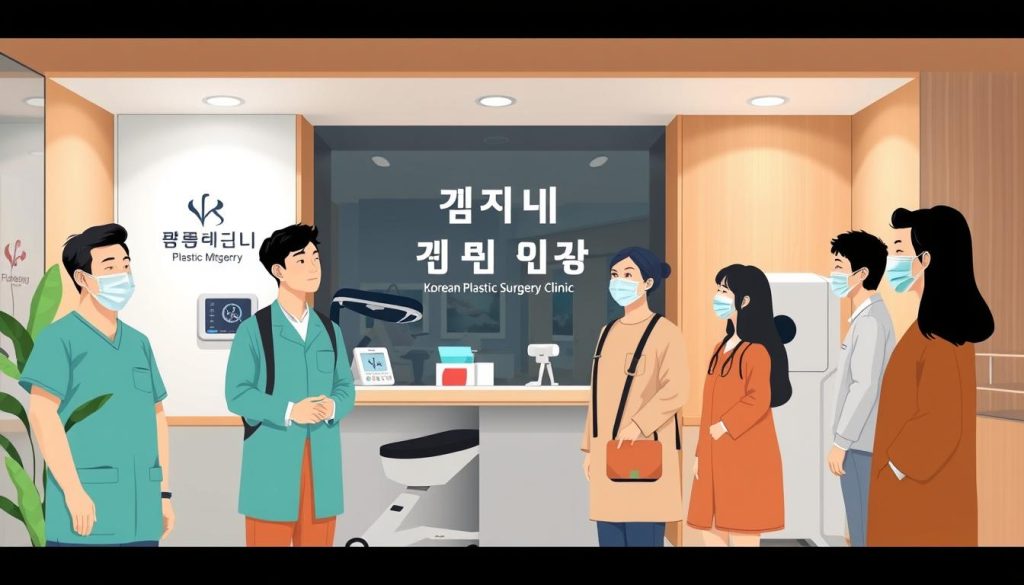
South Korea has emerged as a global hub for plastic surgery, attracting a significant number of international patients. The country’s advanced medical facilities, skilled surgeons, and competitive pricing have made it a preferred destination for those seeking cosmetic procedures.
Why Foreigners Choose Korea for Cosmetic Procedures
Foreigners are drawn to Korea for plastic surgery due to the country’s expertise in delivering high-quality, natural-looking results. The emphasis on advanced techniques and technologies, combined with the relatively low costs, makes Korea an attractive option. Many clinics cater specifically to international patients, offering services in multiple languages and streamlined processes for foreign visitors.
The average international patient spends 7-14 days in Korea, combining their surgical procedure with recovery time and tourism activities. This allows patients to experience Korean culture while undergoing treatment.
Statistics on International Patients
The number of international patients seeking plastic surgery in Korea has grown steadily over the years. In 2019, a total of 211,218 tourists visited South Korea specifically for cosmetic procedures. Chinese patients represent the largest demographic of international visitors, followed by Thai, Japanese, and increasingly American and European patients.
Many clinics report that 30-40% of their patient base now comes from outside Korea, prompting the development of specialized international patient services. The Korean government actively supports medical tourism through simplified visa processes and certification programs for clinics serving international patients.
The growth in medical tourism for plastic surgery in Korea is a testament to the country’s capabilities in delivering high-quality cosmetic procedures. As the industry continues to evolve, it is likely that Korea will remain a top destination for international patients seeking plastic surgery.
Finding the Right Plastic Surgeon in Korea
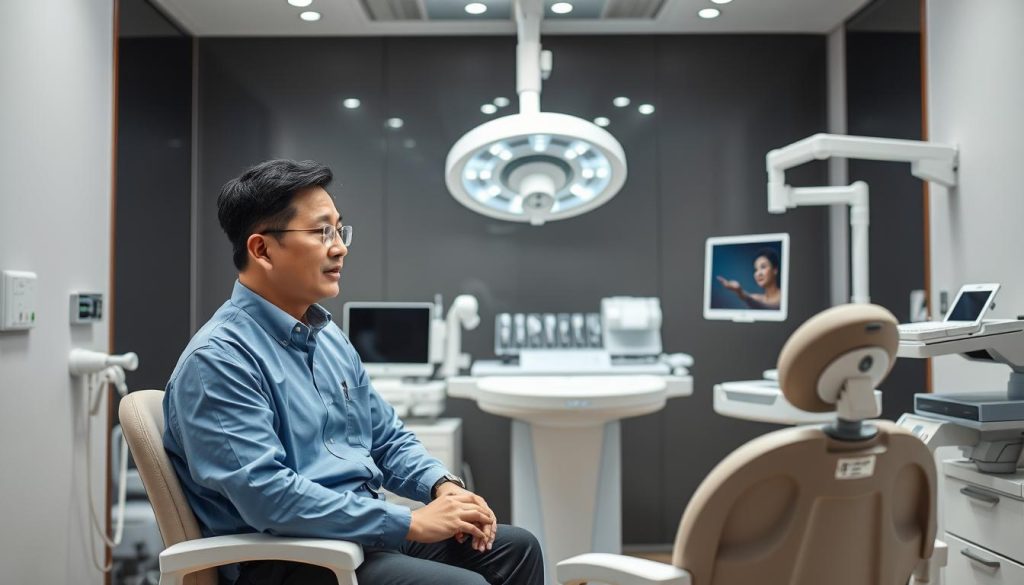
The key to a successful plastic surgery experience in Korea lies in choosing a skilled and experienced surgeon. With the country’s reputation for excellence in cosmetic procedures, it’s essential to do thorough research.
Qualifications and Certifications to Look For
When searching for a plastic surgeon in Korea, it’s vital to check their qualifications and certifications. A reputable surgeon should be board-certified by the Korean Society of Plastic and Reconstructive Surgeons. Dr. Myung Ju Lee M.D. Ph.D., for instance, is a prominent board-certified Korean Plastic Surgeon specializing in autologous cartilage nose, anti-aging, and body contouring surgeries.
To verify a surgeon’s credentials, one can utilize medical tourism agencies with established reputations for vetting surgeons. Additionally, researching through the Korean Medical Association and Korean Society of Plastic and Reconstructive Surgeons official websites can provide valuable information.
How to Research and Verify Credentials
Verifying that the clinic is registered with the Korean Ministry of Health and Welfare and holds proper licensing is crucial. Reviewing before-and-after galleries critically, looking for consistent results and cases similar to your own situation, can also help in making an informed decision.
Scheduling video consultations with multiple surgeons allows you to assess their communication style, understanding of your goals, and willingness to discuss risks and limitations. This step is essential in finding a surgeon who meets your needs and ensures a successful surgery experience.
The Consultation Process
Before undergoing surgery, it’s essential to understand what to expect during the initial consultation. This meeting with your plastic surgeon is crucial in determining the success of your surgery.
Initial Consultation Expectations
During your initial consultation, you will discuss your goals and determine the best course of action for your surgery. Your surgeon will assess your case and recommend the most suitable procedures. For international clients, many clinics offer comprehensive services, including airport pick-up, accommodation for major surgeries, and daily post-care. Most importantly, consultations with doctors and consultants are often complimentary until you are satisfied.
Key Questions to Ask
To ensure you’re well-prepared, consider asking your plastic surgeon the following questions:
- What experience do you have with my desired procedure, and how many cases do you perform annually?
- Can you provide before-and-after photos of patients with similar features who underwent the same procedure?
- What surgical technique do you recommend for my case, and why do you prefer it?
- How do you typically address potential complications, and what are the common risks associated with the surgery?
- What is the recovery process like, and how many days should I plan to stay in Korea after surgery?
By asking these questions, you can gain a better understanding of what to expect and achieve the desired results from your surgery. Your surgeon will be able to provide personalized guidance and help you make an informed decision.
Preparing for Plastic Surgery in Korea
To ensure a smooth experience, understanding the preparations needed for plastic surgery in Korea is vital. This involves several steps, from understanding pre-surgery requirements to arranging travel and accommodation.
Pre-Surgery Requirements and Recommendations
Before undergoing plastic surgery, it’s crucial to follow the guidelines provided by your surgeon and clinic. Many premium clinics offer comprehensive packages for international patients, including airport transfers, accommodation, and translation services. It’s advisable to stay in accommodations close to your clinic, particularly during the initial recovery period when frequent follow-up visits are required.
- Consider the length of your stay carefully – most surgeons recommend remaining in Korea for at least 7-14 days after surgery, depending on the procedures.
- Travel insurance that covers medical complications is essential, though most policies exclude elective cosmetic procedures.
- Plan for a recovery-friendly environment with access to food delivery services and minimal need for physical exertion or public transportation.
Travel and Accommodation Considerations
For international clients, many clinics provide an airport pick-up service, accommodation (for major surgeries), and daily post-care service. Please note that the choice of accommodation can significantly impact your recovery experience.
| Service | Description |
|---|---|
| Airport Pick-up | Convenient transportation from the airport to your accommodation. |
| Accommodation | Arranged for major surgery cases, ensuring proximity to the clinic. |
| Post-care Service | Daily care and monitoring after surgery. |
By carefully planning your travel and accommodation, you can ensure a comfortable and stress-free recovery period.
The Surgery Experience in Korean Clinics
Undergoing surgery in a Korean clinic is a unique experience that combines advanced medical technology with personalized care. Korean clinics have established a reputation for delivering high-quality surgical outcomes, supported by rigorous standards and innovative practices.
Facility Standards and Amenities
Korean clinics are known for their modern facilities and comprehensive amenities. These clinics are equipped with state-of-the-art surgical equipment and recovery rooms designed to ensure patient comfort. The typical facility standards include:
- Advanced surgical technology
- Comfortable recovery areas
- Professional medical staff
- Personalized care services
Advanced Surgical Techniques are a hallmark of Korean clinics, with many clinics adopting the latest technologies to minimize recovery time and enhance surgical precision. For instance, the use of local anesthesia with sedation is common, allowing patients to recover quickly and safely.
Day of Surgery: What to Expect
On the day of surgery, patients typically arrive at the clinic 1-2 hours before the scheduled procedure for final preparations. Pre-operative procedures include changing into surgical garments, meeting with the anesthesiologist, and having surgical markings drawn by the surgeon. Please note that most procedures are performed under local anesthesia with sedation, reducing risks and recovery time.
The surgery duration can range from 1-5 hours, depending on the complexity of the procedure. After surgery, patients are monitored in a recovery area until stable, typically for 2-3 hours, before being discharged to their accommodation.
Data indicates that the surgery time typically ranges from 3-4.5 hours, and patients can leave the clinic after 2-3 hours. Follow-up check-ups are usually required three times after the surgery.
Recovery and Aftercare
Korean clinics emphasize comprehensive recovery and aftercare to ensure patients achieve optimal results from their plastic surgery. The recovery process is tailored to the specific procedure, and clinics provide detailed guidance to support patients throughout their healing journey.
Typical Recovery Timelines for Different Procedures
Recovery times can vary significantly depending on the type of plastic surgery performed. Generally, patients can expect to return to their normal appearance within 3-5 weeks. However, it may take 9-12 months for the full results of the surgery to settle. For instance, facial contouring procedures like V-Line surgery may have a shorter recovery time compared to more invasive surgeries such as body contouring.
| Procedure | Typical Recovery Time | Full Results |
|---|---|---|
| Double Eyelid Surgery | 1-2 weeks | 3-6 months |
| Rhinoplasty | 2-3 weeks | 6-12 months |
| V-Line Surgery | 2-4 weeks | 6-9 months |
Post-Operative Care and Follow-up Appointments
Korean clinics are renowned for their meticulous post-operative care. Patients typically have multiple follow-up appointments during the first week after surgery to monitor healing and remove stitches or dressings. Specialized care may include LED light therapy, ultrasound treatments, and lymphatic drainage massage to reduce swelling and enhance results.
- Detailed written instructions are provided in multiple languages to ensure clarity.
- Many clinics offer 24/7 hotlines for patients to address any concerns during recovery.
- For international patients, clinics often coordinate with healthcare providers in the patient’s home country for continued care after returning home.
- Digital follow-ups through secure platforms allow surgeons to monitor long-term healing.
As one patient noted, “The aftercare at the Korean clinic I visited was exceptional. The staff were always available to answer my questions, and the follow-up appointments were thorough.” This level of care underscores the commitment of Korean clinics to ensuring a smooth and successful recovery.
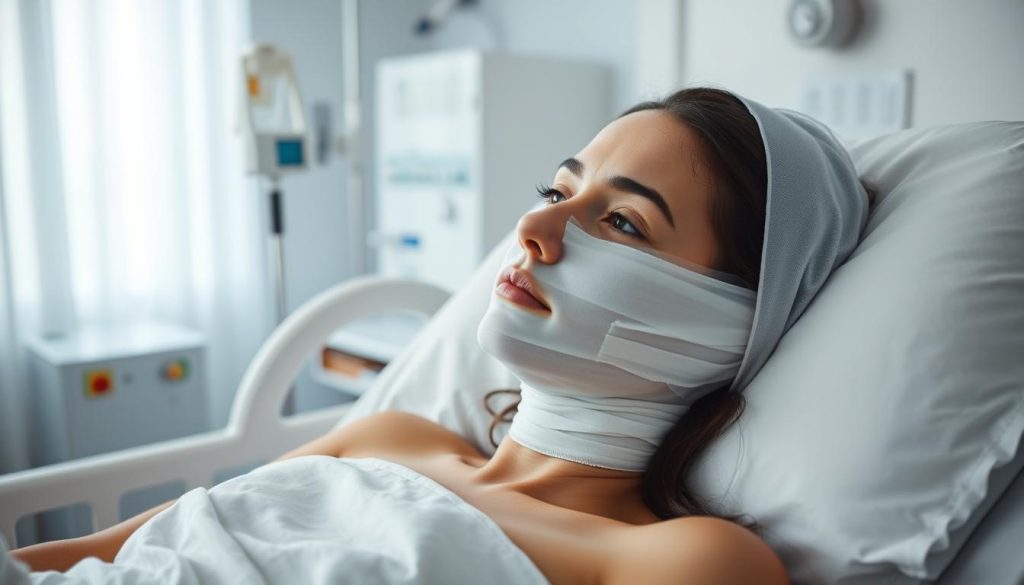
Potential Risks and Complications
While plastic surgery can significantly enhance one’s appearance and confidence, it’s crucial to understand the potential risks involved. As with any surgical procedure, plastic surgery carries the risk of complications that can affect the outcome and recovery.
Common Side Effects and Complications
Common side effects of plastic surgery can include swelling, bruising, and discomfort in the days following the surgery. More serious complications, although rare, can occur. These may include infection, scarring, and adverse reactions to anesthesia. In some cases, patients may experience unsatisfactory results, necessitating revision procedures.
Data from revision rhinoplasty cases shows that a significant percentage were originally performed by inexperienced surgeons with insufficient training. This highlights the importance of choosing a qualified and experienced surgeon and a reputable clinic or surgery center.
How Korean Clinics Address and Minimize Risks
Korean clinics are known for their high standards and advanced techniques to minimize risks. Top clinics employ specialized doctors who focus on specific procedures, reducing the likelihood of complications. Advanced pre-operative planning using 3D imaging and computer simulation helps identify potential issues before surgery.
- Strict sterilization protocols and modern operating facilities significantly reduce infection risks.
- Comprehensive pre-operative screening identifies patients with higher risk factors, allowing for customized surgical plans.
- Established clinics maintain detailed records of complications and outcomes to continuously refine techniques and let patients know of realistic risk assessments.
By understanding these measures and choosing a reputable clinic, patients can minimize their exposure to risks and complications, ensuring a smoother recovery over several days and a more satisfactory outcome.
Controversies in Korean Plastic Surgery
The world of Korean plastic surgery is not without its controversies, with several issues drawing criticism from both within and outside the country. While the industry has made significant advancements and attracted numerous international patients, it also faces challenges related to ethical practices and societal pressures.
Ghost Surgeries: Understanding the Issue
One of the significant controversies surrounding Korean plastic surgery is the practice of “ghost surgeries.” This occurs when a surgeon other than the one consulted performs the surgery. This can lead to a lack of accountability and potentially compromise patient safety. The issue has raised concerns among international patients who travel to Korea for plastic surgery procedures, expecting a certain level of care and expertise.
To address this issue, many clinics have started to implement stricter protocols, ensuring that patients are fully informed about their surgery and the team involved. However, the prevalence of ghost surgeries remains a concern, highlighting the need for greater transparency and regulation within the industry.
Beauty Standards and Social Pressure
Korean beauty standards have been criticized for creating unrealistic expectations, particularly for women, leading to psychological pressure and body image issues. The prevalence of plastic surgery in entertainment and media normalizes cosmetic procedures and contributes to social pressure to conform to specific beauty ideals. The “Escape the Corset” movement has emerged as a response to these pressures, promoting body positivity and challenging conventional beauty standards.
Studies have shown correlations between exposure to Korean beauty standards and decreased self-esteem among young people. Employment discrimination based on appearance remains a controversial issue, with many companies still considering physical attractiveness in hiring decisions. These societal pressures underscore the need for a more nuanced discussion around beauty and Korean plastic surgery.
As the industry continues to evolve, it is crucial to address these controversies and work towards creating a more ethical and patient-centric environment. By doing so, Korean plastic surgery can maintain its reputation for excellence while also promoting positive change in societal attitudes towards beauty and surgery.
Success Stories and Results
With its state-of-the-art facilities and experienced surgeons, Korea has become a hub for plastic surgery, attracting patients from around the world. The country’s plastic surgery industry has garnered significant attention globally, with many patients sharing their positive experiences and results.
Before and After Transformations
The transformations achieved through Korean plastic surgery are often remarkable, with patients experiencing significant improvements in their appearance and confidence. Many patients have reported natural-looking results that enhance their features without appearing overly done.
Some of the most common procedures that yield impressive before and after transformations include double eyelid surgery, rhinoplasty, and facial contouring. These procedures, when performed by skilled surgeons, can lead to dramatic yet subtle changes in a patient’s appearance.
| Procedure | Average Satisfaction Rate | Common Benefits |
|---|---|---|
| Double Eyelid Surgery | 95% | Enhanced eye appearance, more defined eyelid |
| Rhinoplasty | 92% | Improved nasal shape, better breathing |
| Facial Contouring | 90% | Smoother facial lines, more balanced features |
Patient Testimonials and Experiences
Patients often highlight the comprehensive care received throughout their surgical journey, from initial consultation through recovery. Many patients praise the professionalism and attention to detail exhibited by top Korean surgeons, particularly in complex procedures.
Recovery experiences typically note the effectiveness of Korean post-operative care in minimizing discomfort and accelerating healing. Long-term satisfaction reports demonstrate the durability of results and the positive psychological impact many patients experience following successful surgery.

The success stories of patients who have undergone plastic surgery in Korea are a testament to the country’s advanced medical capabilities and the skill of its surgeons. As more patients share their positive experiences, Korea’s reputation as a premier destination for plastic surgery continues to grow.
Legal and Ethical Considerations for International Patients
As the popularity of Korean plastic surgery grows among international patients, understanding the legal landscape becomes increasingly important. International patients must be aware of their rights and the protections available to them when undergoing surgery in Korea.
Patient Rights and Protections
Korean law prohibits ghost surgery, where an unqualified doctor performs the operation. Although it’s illegal, proving ghost surgery can be challenging due to lack of evidence. In response to public concerns, South Korea has mandated the installation of security cameras in operating rooms to enhance transparency and patient safety.
Reputable Korean clinics have established protocols to support international patients, including:
- Direct contact information for patients to reach out in case of complications after returning home.
- Partnerships with local surgeons and medical facilities abroad to provide emergency care if needed.
It’s essential for patients to inform their primary care physicians about their procedures before traveling to ensure appropriate follow-up care. This proactive step helps in managing potential complications and ensures continuity of care over the coming days.
Addressing Complications After Returning Home
In cases where complications arise after an international patient returns home, several measures can be taken. Many Korean clinics offer digital consultations, allowing their plastic surgeons to assess the healing process remotely and provide guidance to local healthcare providers.
To facilitate smooth recovery, patients should obtain detailed documentation of their procedures, including operative notes and medication information, before leaving Korea. This documentation is crucial for local healthcare providers to understand the specifics of the surgery performed and provide appropriate post-operative care over the subsequent days or even days later.
By understanding these legal and ethical considerations, international patients can make informed decisions about their surgery in surgery korea and ensure a safer, more successful experience.
Making an Informed Decision About Korean Plastic Surgery
The decision to undergo plastic surgery in Korea should be made after thorough research and consideration. With its advanced techniques and competitive pricing, Korean plastic surgery has become a popular choice for individuals seeking cosmetic procedures.
When selecting a plastic surgeon, it’s essential to focus on specialists who frequently perform the desired procedure, rather than general plastic surgeons. This is particularly important for complex procedures like rhinoplasty or neck lift surgery, where expertise can significantly impact the outcome.
To make an informed decision, consider the full cost, including travel, accommodation, and potential revision surgery. Be realistic about recovery time and plan to stay in Korea long enough for critical follow-up appointments. It’s also crucial to verify that your chosen surgeon in Korea personally performs the procedures and doesn’t operate a high-volume surgery clinic where quality may be compromised.
Additionally, evaluate your motivations carefully, ensuring that you’re pursuing surgery for personal satisfaction rather than to meet others’ expectations. Prepare for the possibility that results may differ from your expectations, and discuss with your doctor how potential revisions would be handled.
Consider cultural and language differences that may impact your experience. Working with medical tourism agencies can help bridge these gaps. Review the clinic’s policies regarding complications and revisions before committing to surgery. Take time to reflect on your decision, avoiding rushed choices based on promotional offers or limited-time discounts.
By carefully considering these factors and doing thorough research, you can make an informed decision about Korean plastic surgery that meets your needs and expectations.
FAQ
What are the most popular plastic surgery procedures in Korea?
The most sought-after procedures include double eyelid surgery, rhinoplasty, V-line surgery, and body contouring. These procedures are popular among both locals and international patients.
How do I choose the right plastic surgeon in Korea?
To choose the right surgeon, look for qualifications and certifications from reputable medical organizations. Research their experience, especially in the procedure you’re interested in, and verify their credentials.
What is the typical recovery time for plastic surgery procedures?
Recovery times vary depending on the procedure. For example, double eyelid surgery may require a few days to a week of recovery, while body contouring can take several weeks. Your surgeon will provide a detailed recovery timeline.
Are Korean clinics equipped to handle complications?
Reputable Korean clinics have measures in place to minimize risks and address complications. They often have emergency protocols and provide post-operative care to ensure a smooth recovery.
Can I get a free consultation before deciding on a procedure?
Many Korean clinics offer free initial consultations to discuss your options, answer questions, and outline the procedure. This is a great opportunity to assess the clinic’s standards and the surgeon’s expertise.
How do costs compare between Korea and other countries?
The cost of plastic surgery in Korea is often competitive compared to countries like the United States. However, costs can vary widely depending on the procedure, surgeon, and clinic.
What should I consider when planning travel and accommodation for plastic surgery in Korea?
When planning your trip, consider the location of the clinic, travel time, and accommodation options. Some clinics offer package deals that include accommodation and transportation.
Are Korean plastic surgeons experienced in handling international patients?
Many Korean plastic surgeons have experience with international patients and are accustomed to working with diverse cultural backgrounds and languages.
